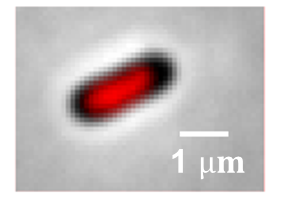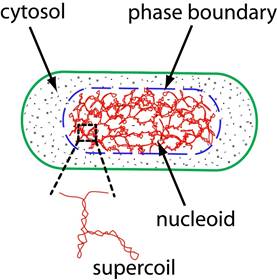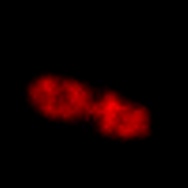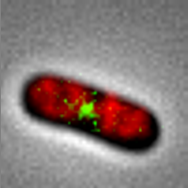Organization of bacterial chromosome in a bacterial cell
The goal of our research is to provide better understanding on how DNA in E. coli cell is physically organized and what factors are essential for its compaction.
An E. coli cell and its fluorescently labelled chromosome (red) |
A working model for the organization of chromosomal DNA within a bacterial cell. The nucleoid consists of supercoiled DNA that is cross-linked by DNA binding proteins. The nucloid and the rest of the cytosol form distinct phases in the cell (following T. Odijk and C. Woldringh). |
Chromosomal DNA in E. coli has contour length of about 1.6 mm while the rod-shaped bacterium is only few micrometers long and about 0.8 μm in diameter. Interestingly, the long DNA molecule does not fill the whole cell interior but only a sub-region, termed the nucleoid, which occupies about 25-50% of the internal volume (Top Left).
The level of compaction of chromosomal DNA and its folding within the nucleoid affects several essential processes in the cell including DNA replication and repair, and transcription. In fact, taking that DNA compaction has an effect on the transcriptional actvity means that essentially all cellular processes are affected by DNA packing. Despite significance of DNA compaction to cellular function, it is still poorly understood what compacts the DNA within the nucleoid. Confinement by cell wall, macromolecular crowding, supercoiling and DNA binding proteins have all been implicated to play a role. At the same time some DNA related processes such as transcription and transertion (coupled transcription, translation and membrane insertion) have propensity to expand the DNA. More and more evidence has been collected over the past years that macromolecular crowding is the most dominant factor among those listed above. It is likely that crowders and DNA phase separate in the bacterial cell forming a crowder rich cytoslic phase and a crowder poor nucleoid phase (as shown above left).
While crowding plays an important role, it is clear that DNA binding proteins should not be completely discounted either. In fast growth conditions the DNA structure deviates strongly from that of random polymer coil, which should be overall homogeneous (see below).
An image of E. coli nucleoid in fast growth conditions |
A composite image of the nucleoid (red), its replication terminus region (green) and cell contours (grey) |
Interplay of different factors in determining the folding of the DNA within the nucleoid thus remains yet to be answered question that we work on.



